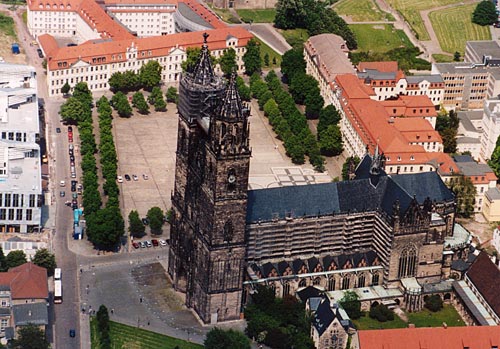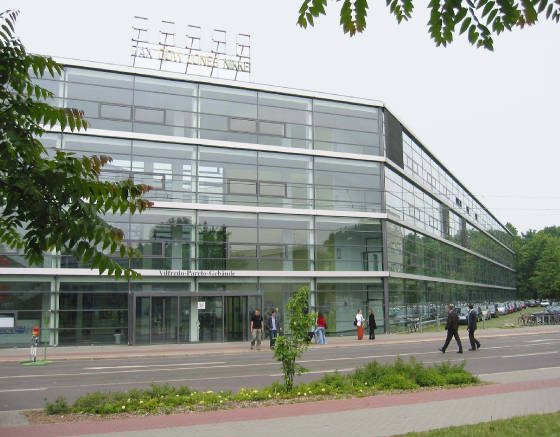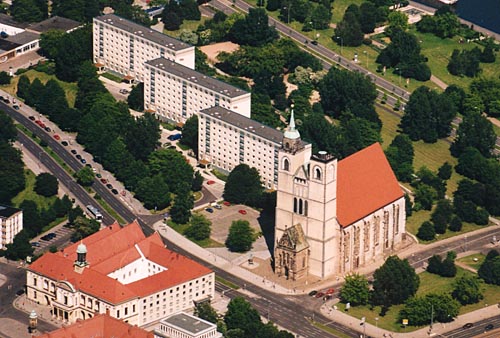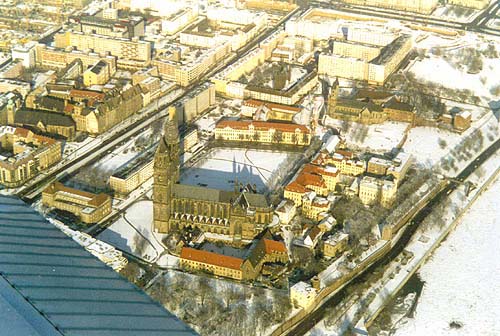 The town was one of the oldest emporia of the German trade for the Wends who dwelt on the right bank of the Elbe. In 805 it is first mentioned in history. In 806 Charlemagne built a fortress on the eastern bank of the
river opposite Magdeburg. The oldest church is also credited to the epoch. Magdeburg first played an important part in the
history of Germany during the reign of Otto the Great (936-73). His consort Editha had a particular
love for the town and often lived there. The emperor also continually returned to it. On 21 September, 937, Otto founded a
Benedictine monastery at Magdeburg, which was dedicated to Sts. Peter, Maurice, and the Holy Innocents. The first abbots and
monks came from St. Maximin's at Trier. Later on Otto conceived the plan of establishing an archbishopric at Magdeburg, thus
making it a missionary centre for the Wends on the eastern bank of the Elbe. He succeeded in carrying out his idea after various
changes and difficulties. The glory of the archbishopric increased rapidly, the town also became more important.
The town was one of the oldest emporia of the German trade for the Wends who dwelt on the right bank of the Elbe. In 805 it is first mentioned in history. In 806 Charlemagne built a fortress on the eastern bank of the
river opposite Magdeburg. The oldest church is also credited to the epoch. Magdeburg first played an important part in the
history of Germany during the reign of Otto the Great (936-73). His consort Editha had a particular
love for the town and often lived there. The emperor also continually returned to it. On 21 September, 937, Otto founded a
Benedictine monastery at Magdeburg, which was dedicated to Sts. Peter, Maurice, and the Holy Innocents. The first abbots and
monks came from St. Maximin's at Trier. Later on Otto conceived the plan of establishing an archbishopric at Magdeburg, thus
making it a missionary centre for the Wends on the eastern bank of the Elbe. He succeeded in carrying out his idea after various
changes and difficulties. The glory of the archbishopric increased rapidly, the town also became more important.
The city of Magdeburg obtained from the archbishops a charter that was
the model for hundreds of medieval town charters in Germany, Austria, Bohemia, and Poland. Under this Magdeburg Law a town
governed itself through an elected council, had its own courts of justice, and was exempt from all duties except the payment
of rent to the prince of the land. Magdeburg prospered and became one of the chief members of the Hanseatic League. It accepted
(1524) the Reformation, joined (1531) the Schmalkaldic League, and continued its resistance against Emperor Charles V until
its fall (1551) to Maurice of Saxony. The archbishops were converted to Protestantism, and the family, members of the house
of Brandenburg, ruled the archbishopric as administrators. The Magdeburg Centuries, the first comprehensive history of Protestantism,
was edited there in the late 16th cent.
During the Thirty Years War the imperial forces laid siege to Magdeburg
in 1630. On May 20, 1631, the imperial troops under Tilly and Pappenheim stormed the city and put the garrison to the sword.
Fires mysteriously broke out in various quarters, and by the following day virtually the entire city had burned down. Roughly
25,000 persons (about 85% of the city’s population) perished in the conflagration and the sacking. The sack of Magdeburg
produced an immense impression and caused the Protestant princes to conclude a closer alliance. The city was rebuilt and its
 trade revived after the Peace of Westphalia (1648), which transferred both the city and the archbishopric (which was
secularized and made a duchy) to the electorate of Brandenburg. From the late 17th cent. Magdeburg was an important Prussian
fortress. The city was severely damaged in World War II.
trade revived after the Peace of Westphalia (1648), which transferred both the city and the archbishopric (which was
secularized and made a duchy) to the electorate of Brandenburg. From the late 17th cent. Magdeburg was an important Prussian
fortress. The city was severely damaged in World War II.
Historic landmarks of Magdeburg include
an 11th-century Romanesque church and the 13th-century cathedral. The city is the birthplace of Otto von Guericke (1602–86),
the physicist and inventor of the Magdeburg hemispheres (which demonstrate air pressure); the composer G. P. Telemann (1681–1767);
and Baron von Steuben (1730–94), the Prussian general who fought in the American Revolutionary War.
(picture : Russell Sturgis Collection, Washington University Archives, St. Louis
Missouri.)
Visit official website for more details.
http://www.magdeburg.de/


 The town was one of the oldest emporia of the German trade for the Wends who dwelt on the right bank of the Elbe. In 805 it is first mentioned in history. In 806 Charlemagne built a fortress on the eastern bank of the
river opposite Magdeburg. The oldest church is also credited to the epoch. Magdeburg first played an important part in the
history of Germany during the reign of Otto the Great (936-73). His consort Editha had a particular
love for the town and often lived there. The emperor also continually returned to it. On 21 September, 937, Otto founded a
Benedictine monastery at Magdeburg, which was dedicated to Sts. Peter, Maurice, and the Holy Innocents. The first abbots and
monks came from St. Maximin's at Trier. Later on Otto conceived the plan of establishing an archbishopric at Magdeburg, thus
making it a missionary centre for the Wends on the eastern bank of the Elbe. He succeeded in carrying out his idea after various
changes and difficulties. The glory of the archbishopric increased rapidly, the town also became more important.
The town was one of the oldest emporia of the German trade for the Wends who dwelt on the right bank of the Elbe. In 805 it is first mentioned in history. In 806 Charlemagne built a fortress on the eastern bank of the
river opposite Magdeburg. The oldest church is also credited to the epoch. Magdeburg first played an important part in the
history of Germany during the reign of Otto the Great (936-73). His consort Editha had a particular
love for the town and often lived there. The emperor also continually returned to it. On 21 September, 937, Otto founded a
Benedictine monastery at Magdeburg, which was dedicated to Sts. Peter, Maurice, and the Holy Innocents. The first abbots and
monks came from St. Maximin's at Trier. Later on Otto conceived the plan of establishing an archbishopric at Magdeburg, thus
making it a missionary centre for the Wends on the eastern bank of the Elbe. He succeeded in carrying out his idea after various
changes and difficulties. The glory of the archbishopric increased rapidly, the town also became more important. trade revived after the Peace of Westphalia (1648), which transferred both the city and the archbishopric (which was
secularized and made a duchy) to the electorate of Brandenburg. From the late 17th cent. Magdeburg was an important Prussian
fortress. The city was severely damaged in World War II.
trade revived after the Peace of Westphalia (1648), which transferred both the city and the archbishopric (which was
secularized and made a duchy) to the electorate of Brandenburg. From the late 17th cent. Magdeburg was an important Prussian
fortress. The city was severely damaged in World War II. 




